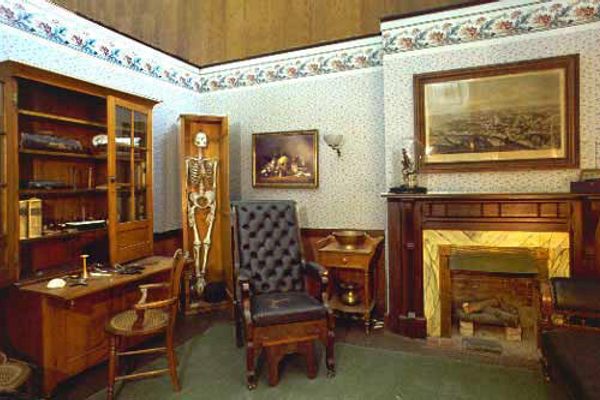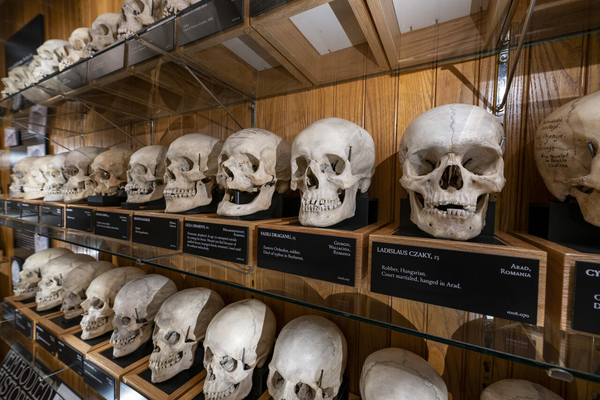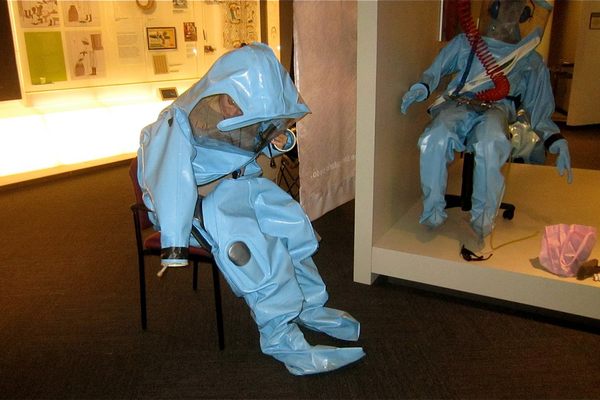Birth Rights: Exploring the Medical Fight Over “Labor” in the 18th Century
Obstetrical Manikin in the Dittrick Museum, Cleveland, Ohio (photograph by Laura Travis)
This journey of birth began, for the Dittrick Museum of Medical History, with a headless anatomical manikin.
Composed of wicker or wire or actual human pelvic bones, covered with chamois leather, housing a collection of springs, bags, levers, thread and colored liquor — these strange devices all have an unusual place in one of the most virulent debates of obstetrical history. Namely, who has final authority over the body in labor? The latest exhibition at the Dittrick, where I serve as Research Associate, focuses on the birthing manikins and other devices that shifted midwifery away from women and into the hands of surgeons.
In the 18th century, traditional female midwives were replaced by “man-midwives” — doctors trained by other doctors who used instruments like the forceps. Dr. William Smellie, for instance, trained 900 man-midwives in 10 years. How could a single professional train so many in so little time? The answer was technology — and it would revolutionize obstetrical training (and the meaning of whose labor really mattered). Smellie resolved to create “machines which should so exactly imitate real women and children as to exhibit to the learner all the difficulties that happen in midwifery,” contrived and made, says the man-midwife in his 1877 Treatise on the Theory and Practice of Midwifery, “by dint of uncommon labour.”
Ivory Anatomical Manikin at the Dittrick Museum, Cleveland, Ohio (photograph by Laura Travis)
Making New Feet
That the midwife might claim credit for “birthing” the baby — replacing the laboring woman with her own “labors” — strikes us today as ridiculous and even repellent. However, even in France, where female practitioners were primary, the midwife was responsible for “making new feet,” as Nina Gelbart cites in The King’s Midwife: A History and Mystery of Madame du Coudray. Our shock at such statements has to do, in part, with our own cultural context — we privilege the concept of “natural birth” wherein the mother takes center stage. But what do we mean?
Women have been giving birth without modern medical intervention for many centuries, but that does not mean they gave birth all alone and without help. Human birth is complicated and our offspring are larger in proportion to our bodies, and yet more helpless than many other mammals. As a result, someone usually helps, supports, or intervenes in some way during the process. Shifts in method are not, therefore, so surprising — though the speed at which they take place sometimes is! What, then, were the historical practices, events, discoveries, politics, and stressors that gave rise to men-midwives?
 Kahun Gynaecological Papyrus, Petrie Museum inventory number UC32057 (Copyright of the Petrie Museum of Egyptian Archaeology, UCL)
Kahun Gynaecological Papyrus, Petrie Museum inventory number UC32057 (Copyright of the Petrie Museum of Egyptian Archaeology, UCL)
The Advent of Technology
I return once more to that headless anatomical manikin: the 18th century obstetrical phantom. In 2010, the Dittrick acquired an obstetrical manikin originally constructed in France. It is not as complete as the famous manikin of French midwife Madame du Coudray (housed in Rouen, France), but is compelling in its own right. It may even have been used by one of du Coudray’s students, nearly all of whom were women. This was not the case in England or Italy, however, where the majority of students working on obstetrical manikins were men — future man-midwives who paid a fee for instruction so as to set up shop on their own. For William Smellie, the device allowed male students to practice another technological advancement — the forceps — without the danger of injuring a live woman.
Technology, for Smellie, meant saving women, but it had plenty of critics. One of these, midwife Elizabeth Nihell, asked in her 1760 A Treatise on Midwifery: “Must not [the pupil] acquire a habit of the touch exquisitely nice, exquisitely just, for discerning between a mere wooden machine, and a body sensible, delicate, animated, and well organized?” John Burton, a physician, also argued in a 1752 letter to Smellie that “Upon a machine you may do such a Thing,” but never upon live women and their delicate parts. And yet, forceps not only enjoyed favor in the 18th century, they are still used today.
Obstetrical Manikin at the Dittrick Museum, Cleveland, Ohio (photograph by Laura Travis)
Obstetrical manikins are still used today as well, and there are many varieties. As visitors walk through the Dittrick’s history of birth exhibition, they are not merely seeing the unusual devices and practices of a bygone era. Rather, they are looking at our inheritance, an unbroken series of developments that continues today in the high-tech birthing centers around the country. And — in exploring the contest between male and female midwives of the 18th century — they are also witnessing the dawn of a debate that still rages over who, in the end, has birth “rights”: the midwife, the obstetrician, or, at last, the laboring woman herself.
Sometimes an artifact, like the obstetric manikin, serves as inspiration. We have built an entire exhibition around its story — and we look forward to Phase II of our renovation project at the Dittrick, which will carry the story into the 19th century and beyond. We hope you will join us!
The Dittrick’s exhibition on the history of birth is now on view at the museum in Cleveland, Ohio.
Brandy Schillace is Research Associate at the Dittrick Museum of Medical History in Cleveland, Ohio. Check out the Dittrick Museum blog to keep up with the fascinating medical history at the museum.
Sources:
Smellie, William. Treatise on the Theory and Practice of Midwifery. Ed. with Annotations, by Alfred H. McClintock. New Sydenham Society, 1877, 251. Digitized August 2011. Accessed 12/12/2013
Gelbart, Nina. The king’s midwife: a history and mystery of Madame du Coudray. (University of California Press, 1999): 80
Nihell, Elizabeth “A Treatise on Midwifery.” Eighteenth-Century British Midwifery Volume 6. (London: Pickering and Chatto, 2008), 83.
John Burton, A Letter to William Smellie, M.D., Containing Critical and Practical Remarks on His Treatise on the Theory and Practice of Midwifery. (London, 1752), 147.

















Follow us on Twitter to get the latest on the world's hidden wonders.
Like us on Facebook to get the latest on the world's hidden wonders.
Follow us on Twitter Like us on Facebook